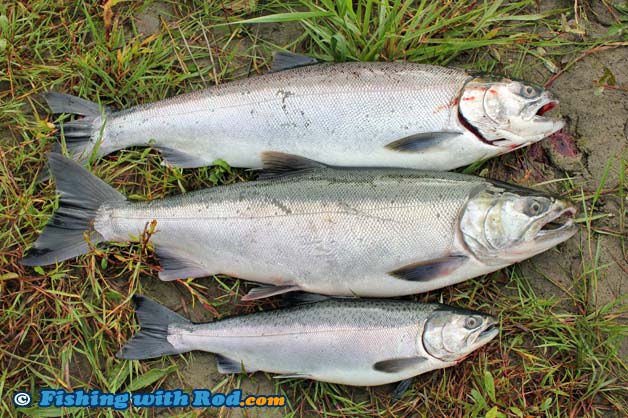What's up with Jack?
By Rodney Hsu, Fishing with Rod | Published in December 2001
Fish come in all sizes, every angler knows that, however a fish needs to reach a certain size to become sexually matured. In the case of Pacific salmon, sexual maturation occurs between 2 to 5 years after birth, depending on the species. During this process, the characteristics of male and female will diverge from an uniform look that they possess in the ocean. Generally, the male will be larger than the female individuals, and individuals within a school of run do not differentiate largely in size. However there are exceptions. Anglers who frequently target salmonids during their returns will often encounter the odd fish that are distinctly smaller. This is often seen in chinook and coho salmon. Why are there such unique differences between the appearances of a male and a female spawning salmon? Why do some fish return into the river earlier than they are expected? More importantly, does size really matter? The theory behind these mysterious behaviours is rather complex and in many cases it resembles the rules of mating in the human society.
Sexual dimorphism
The term sexual dimorphism (di = Two, morph = look=) is simply another jargon that biologists have made up to explain why boys and gals look so apart. By looking at the appearance and behaviour during mating, biologists are able to end the universal question - Who exactly is in charge between the sexes?
In the ocean, it is almost impossible to tell the gender of a salmon because they both look identical. Once entering the freshwater prior to spawning, both genders go through certain changes that will set them apart.
These changes are more evidently shown in male individuals. Hook jaws and sharp teeth are developed, and a hump back can be found in certain species such as pink salmon. The purpose of these changes are thought to be both offensive and defensive. Males need to look big to hold their ground and fight off any threats to search for the mate of their dream. These characteristic changes are also displays to show the gals how large and fit the male is so he should be chosen as the father of her offsprings.
Such phenomenon is not only seen in salmon, but also in just about every species on this planet. Male individuals of some species possess colourful displays. The more colourful you are, the larger chance that you will be chosen by a female. Why do females get to do all the choosing? The answer to this one million dollar question is simple. Eggs are expensive, sperms are cheap, so a female needs to choose wisely as she does not have much to spare.
Jacks are Sneaker Males

Size obviously matters when it comes to mating for salmon. However, being a small male can also succeed when it comes to scoring a female. The so-called "jacks" that are found in chinook and coho salmon are male individuals that return to their natal streams a couple of years earlier than expected.
Although they are much smaller than a fully grown male, they are also sexually matured when they reach the spawning ground. What advantages do these smaller fish have? It is obvious that they will not win when confronted by a fully grown male. Behavioural biologists believe that these jacks are "sneaker males". Their duty is to simply stand by when larger males are fighting for territory, and sneak in while unnoticed to mate with the females that are also waiting for the fights to end. As you can see, being big does not always have all the advantages, sometimes being small can be very beneficial too.
Jacks also serve as a genetic bridge between different year classes of a salmon run. They are recognized as a good insurance policy for the run's survival. Because they are returning one or two years earlier than other adults, these jacks are not from the same parents as the other adults. If a return lacks adult males, then jacks become important sperm providers for that particular population.

